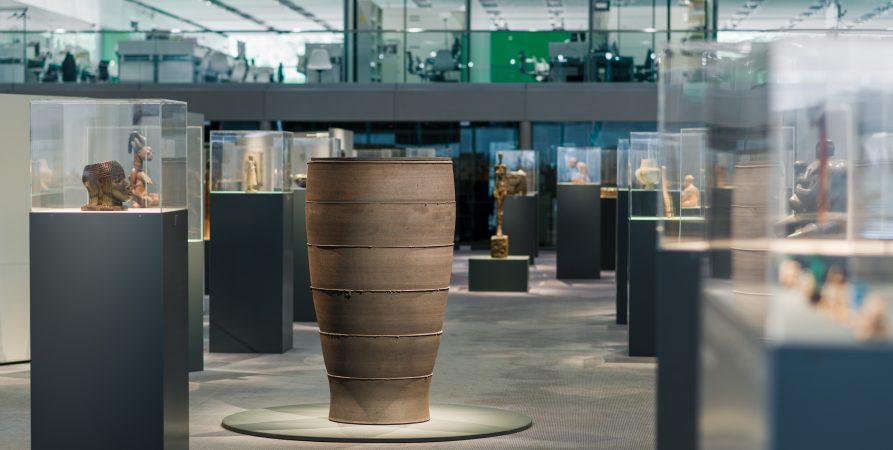Teapot, two cups and stand.
Julian Stair
Life Story
Around 2000, Julian Stair started making pots on hand-built plinths or ‘grounds’. This new development in his work came after his completion of a PhD investigating the history and development of English Studio Ceramics between 1910 and 1940. Stair states that his discovery of a surprising abundance of critical writing on the early development of English Studio Ceramics ‘totally overturned my whole understanding of Studio Pottery, ceramics and art’. [1]
Through his research on the origins of English Studio Ceramics, Stair felt liberated and empowered to buck the current trends and polarised conversations between groups concerned with how pottery should be defined. He started to see pottery as a discipline that artists could interpret in whatever way they felt was most appropriate for the time they were living in. [2]
Stair’s new work was a tribute to the pioneering potters he had studied, who hadn’t restricted themselves in terms of style. He was interested in the work of Reginald Wells, one of the first truly independent studio potters, and discovered an image of him placing pots on a tray, which referenced the Chinese potters he loved, who displayed valuable pots on carved wooden stands. [3]
Stair’s placing of a simple form (such as a cup without a handle) on a plinth broke expectation. In doing so it elevated the form’s status beyond being merely functional, ensuring the experience of the everyday is important:
‘It’s about making art that is the pivot for human behaviour…The social element becomes very important – and how people come together through objects. In childhood I would go to my great aunt’s for tea and at the centre were these china objects: a tea pot, tea cups, a jug for hot water, bowls for slops, and there was a very structured ritual, with conversation on top, as orchestrated as a Japanese tea ceremony.’
‘I think the experience of the tactile, the haptic, is so significant to our understanding of the world, and is so underused in the world of art. When we appreciate objects – touch them – hold them in our hand – somehow it’s a material reinforcement of our physical selves. I’m really interested in the idea of how we negotiate our way through life physically, as well as intellectually.’ [4]
The body of the stoneware teapot is a basalt clay that the artist first developed in the 1970s at Camberwell Art School. Stair created different coloured clays for each piece of the tea set by adding different oxides to the base clay. The teapot handle is made from Japanese wisteria, which has been traditionally used for making handles over centuries. Stair hand built the square grey stoneware ground. This tea set was the last of the artist’s works to be bought by Lady Sainsbury.
Katharine Malcolm, September 2020
[1] John M. Anderson Endowed Lecture Series: ‘A Sense of Place’, The Pennsylvania State University, 18 February 2014: https://www.youtube.com/watch?v=FTyzNba2KL4 (accessed 14 August 2020)
[2] Ibid.
[3] Ibid.
[4] Julian Stair and others, Julian Stair: Quietus Reviewed, Archaeology of an exhibition (Bath: Wunderkammer Press, 2013), p.9.
Further Reading
Stair, Julian, Michael Tooby, Helen Waters, James Beighton, Andrew Renton, and Sophie Hacker and others, Julian Stair: Quietus Reviewed, Archaeology of an exhibition (Bath: Wunderkammer Press, 2013).
John M. Anderson Endowed Lecture Series: ‘A Sense of Place’, The Pennsylvania State University, 18 February 2014: https://www.youtube.com/watch?v=FTyzNba2KL4
Not on display
Title/Description: Teapot, two cups and stand.
Artist/Maker: Julian Stair
Born: 2003
Object Type: Tea service, tea set, teapot
Materials: Stoneware, Wisteria
Technique: Handbuilding, Throwing
Measurements: Teapot: h. 210 x w. 147 x d. 105 mm. Pale cup: diameter: 77 x h. 59 mm. Dark cup: diameter: 82 x h. 66 mm. Stand: l. 275 x w. 274 x h. 65 mm.
Accession Number: 1257
Historic Period: 21st century
Production Place: Britain, England, Europe
School/Style: Studio Ceramics
Copyright: © Julian Stair
Potted History: Julian Stair and the Sainsbury Centre
From meeting Lisa Sainsbury in 1982, to his latest monumental jars, the artist discusses his history with the Centre
Continue reading






